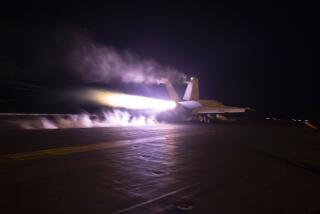Navy conducts first series of drone and manned fighter jet operations
- Share via
Reporting from Washington — The U.S. Navy said its jet-powered, bat-winged X-47B drone has conducted carrier deck operations and performed maneuvers alongside an F/A-18 fighter jet, marking the first time manned and unmanned aircraft have operated together on the same carrier.
Navy officials hailed the test flights of the experimental drone, which were completed Sunday on the Theodore Roosevelt in the eastern Atlantic Ocean, as a milestone in carrier-based naval aviation.
“Today we showed that the X-47B could take off, land and fly in the carrier pattern with manned aircraft while maintaining normal flight deck operations,” Capt. said Beau Duarte, program manager for the Navy’s unmanned carrier aviation office, in a statement. “This is key for the future carrier air wing.”
Combat drones used by the Air Force and CIA are controlled remotely by a human pilot, often sitting thousands of miles away. The Navy drone is designed to carry out a combat mission controlled almost entirely by a computer.
A human pilot would design its flight path and send it on its way. A computer program would guide it from a ship to the target and back.
Unlike the Predator and other propeller-driven combat drones, the X-47B is stealthy and jet-powered. Built by Northrop Grumman Corp., it looks like a mini-B-2 stealth bomber.
The drone has a weapons bay with a payload capacity of 4,500 pounds, but the Navy said it has no plans to arm the aircraft.
After taking off Sunday morning, the drone flew in the landing pattern with the F/A-18 at approach speeds of 120 mph, at a pattern altitude of 1,200 feet, Northrop said.
After a short flight, the X-47B came in for an arrested landing where a deck-based operator used a deck handling control to manually move it out of the way and taxied it out of the landing area.
The F/A-18 then touched down, close behind the drone.
“This cooperative launch and recovery sequence will be repeated multiple times over the course of the planned test periods,” the Navy said. “The X-47B performed multiple arrested landings, catapults, flight deck taxiing and deck refueling operations.”
The drone has a 62-foot wingspan and can fly higher than 40,000 feet. It has a range of more than 2,400 miles and can reach high subsonic speeds. The Navy has nicknamed it “Salty Dog 502.”
Navy fighter pilots may fly missions that last as long as 10 hours. Drones can fly for three times that long.
The X-47B is an experimental jet -- that’s what the X stands for -- and is designed to demonstrate new technology, such as automated takeoffs, landings and refueling.
The Navy said it will continue tests over the next year to demonstrate the integration of unmanned carrier-based aircraft.
The cost of the program, known as Unmanned Carrier Launched Airborne Surveillance and Strike, is estimated at as much as $5.9 billion through 2020, according to the Government Accountability Office.
Interested in the latest news from the Pentagon? Follow @wjhenn for military and defense info.
More to Read
Sign up for Essential California
The most important California stories and recommendations in your inbox every morning.
You may occasionally receive promotional content from the Los Angeles Times.











